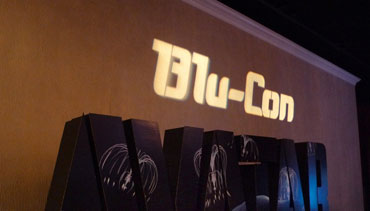Wrap Up: Blu-Con 2010 Page 2

Presidents Forum
Next up was the Presidents Forum. This consisted of: Steve Beeks, President, Lionsgate; David Bishop, President, Sony Pictures Worldwide Home Entertainment; Mike Dunn, President, Twentieth Century Fox Home Entertainment; Craig Kornblau, President, Universal Studios Home Entertainment; and Ron Sanders, President, Warner Home Video. Certainly some heavyweights in the film world. I did not rush the stage to give them my script.
Sanders answered the first question, one on where sales were at this point in the year. He replied that even though DVD was down 14%, Blu-ray sales were up 86% and total sales were up 2% year to date on new releases. Video on Demand was also growing at a significant rate. Beeks felt that the total amount that consumers were spending on all entertainment was at an all time high.
Interestingly, none had a problem with the rental market, despite the two moderators trying to push the opinion that Netflix was hurting business overall. Each studio representative felt that overall Netflix was a good thing, and that if it came to a point where the studio felt it needed more money for the content it was providing to Netflix, they would adjust the contract accordingly. Sanders, Kornblau and Dunn all felt that their studio's 28-day window, where the title is for sale but not for rental, was a benefit to their business to the tune of 10%-15% over titles that didn't have the 28-day delay.
What content each studio gave to Netflix, though, was a harder question to answer. Most felt that older content, "post DVD" according to Dunn, was great for streaming. Others were more cagy, saying that it was an evolving marketplace, and that their studio was currently looking as to what content to provide.
The trick, they all felt, was finding value to add to content to get consumers to buy it.
Blu-ray 3D
The next panel was all about 3D. Panelists were: Kris Brown, Vice President, Worldwide High Def Market Expansion Warner Home Video; Jim Mainard, Head of Production Technology, Dreamworks SKG; Dan Schinasi, Senior Marketing Manager, Consumer Business Division, Samsung Electronics America; and Brian Siegel, Vice President, Home Audio & Home Video Group, Sony Electronics.
All agreed that 3D was the future, but also lamented the lack of content. The announcement at the show was Blu-ray 3D Day, on November 16th, where ten 3D titles will be released. There's also the promise of 40 total titles by year's end. So the lack of content is being at least slightly addressed.
Schinasi wanted to point out that all 3D TVs are also the world's best 2D TVs, something often confused by many consumers.
Brown echoed something Cameron had said, saying that 3D on Blu-ray wasn't going to be enough on its own, that 3D games and TV shows are needed and marketed. He went further, saying that good in-store demos were "vital." This is something that Schinasi said as well. Brown finished by saying his studio, Warner, uses lenticular packaging to differentiate the 3D Blu-rays from others.
Blu-ray Disc Association
After lunch, Andy Parsons, Senior Vice President, Product Development & Corporate Communications, Pioneer Electronics and Chair of the Blu-ray Disc Association's U.S. Promotions Committee, spoke briefly about where sales were for Blu-ray. Despite some stories to the contrary, Blu-ray is selling at roughly the same rate as DVD over the same length of time after launch. If you only count the percentage of the population with HDTVs, the adoption rate is much faster than DVD.
By the end of the year, the BDA estimates over 25 million households will have a Blu-ray player. The BDA also feels that Blu-ray can happily co-exist with online streaming and download services.
Classic Films
The Film Classics panel had: Jeff Baker, Executive Vice President & General Manager, Theatrical Catalog, Warner Home Video; Rita Belda, Director, Asset Management, Film Restoration and Digital Mastering, Sony Pictures Entertainment; Bob Buchi, Senior Vice President, Marketing, Paramount Home Entertainment; and Dave Shaw, Senior Vice President Marketing, Twentieth Century Fox Home Entertainment.
Older films hold huge potential revenue for studios. The trick, as we found out, is deciding what films to choose.
Baker said that the first thing his studio looks for in choosing what titles to release on Blu-ray is the commercial viability of the movie. In other words, if they think the disc will sell well, it gets bumped up the list. The next thing is the film element itself. It can be very costly to remaster a film, especially if you have to restore it. There are exceptions, though. When asked directly about the Blade Runner box set, a movie that did very poorly at the box office, he replied that cult and sci-fi films do really well on disc, regardless of their theatrical performance.
Shaw added that if the film has artistic or technical merit, or will potentially increase the studio's "prestige" then it may also be chosen.
Perhaps most interesting, Belda said that even though Sony had been mastering their films in HD for 15 years, in many cases these weren't of high enough quality to be put directly on Blu-ray. What was "fine" in the case of DVD isn't enough for the higher resolution on Blu-ray. In these cases, they go back to the original negative for the best color, resolution and grain. Worst case they use archival prints and refer to studio notes from the era to determine how it should look.
When possible the studios like to bring the director back in to supervise the new transfer, minimizing fan apoplexy and ensuring the truest version of the director's vision.
The trick, according to all the panelists, is to create content that is compelling enough for consumers to buy. Seems easy when it's put that way, doesn't it?
- Log in or register to post comments



































































